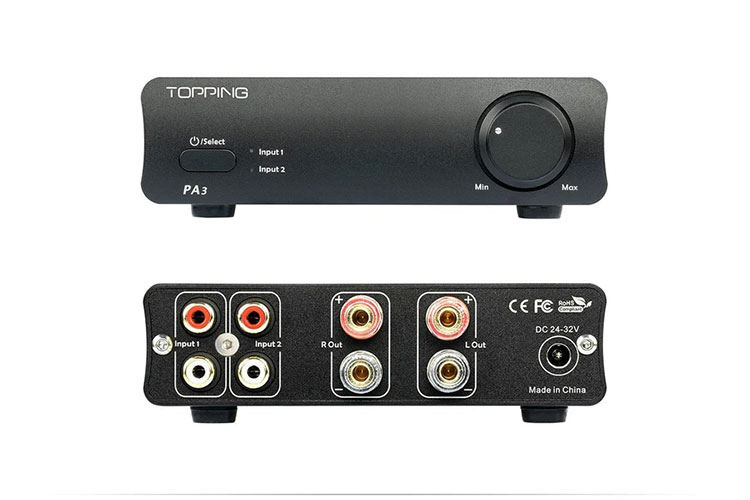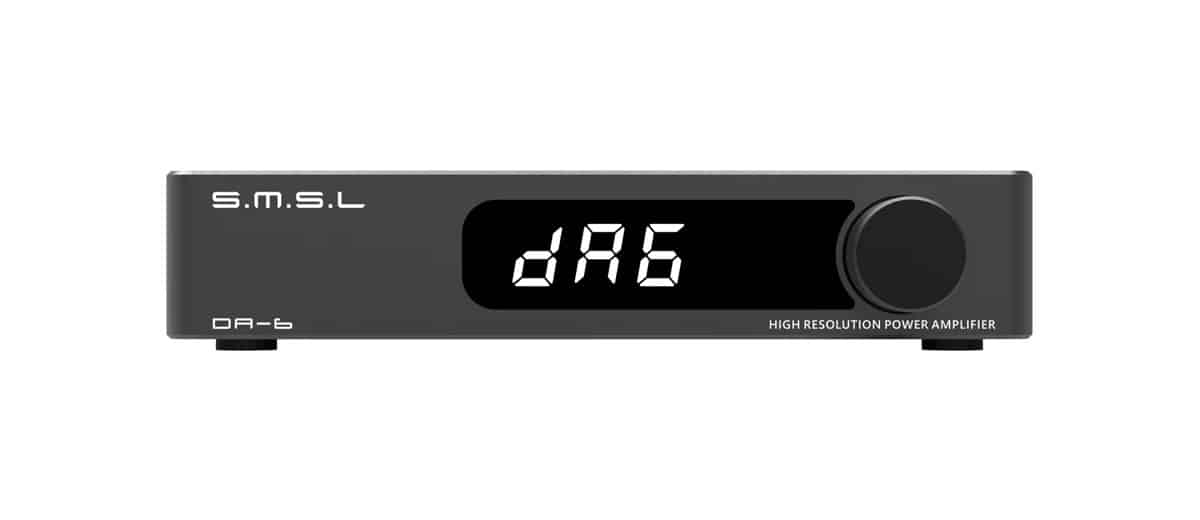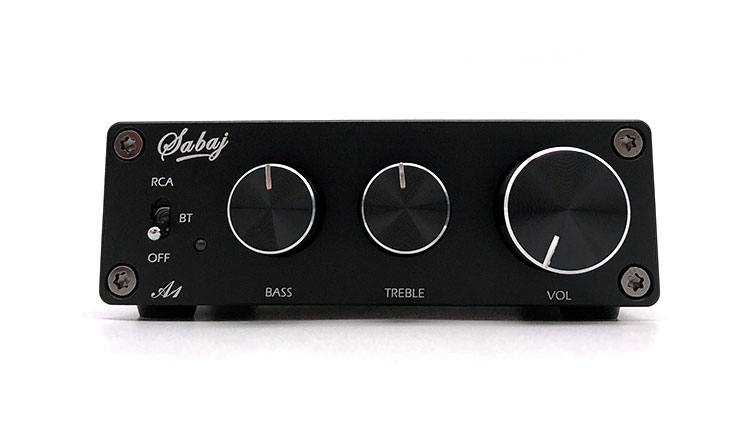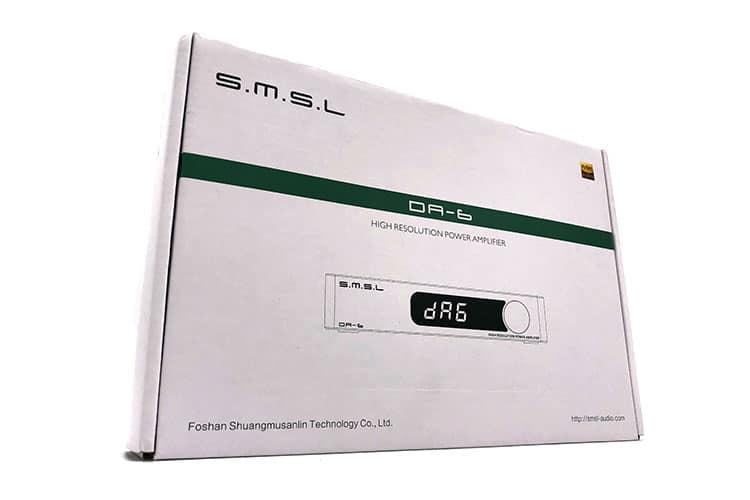Select Comparisons
Topping PA3
$119
Technical
Even though the PA3 is an older device, its burlier TDA749E Class D amp chip bringing up to 80W per channel is still no slouch even by today’s competition. Pushing electrical juice into the PA3 is a justifiably heavy 32V PSU which is necessary to maximize its performance.
More analog right from the ALPS audio potentiometer used in the volume wheel, the PA3 is also equipped with high-quality components sourced from EPCOS, Nichicon, and OMRON.
The PA3 still does have a microcontroller unit involved in the process of protecting the device from overloading, overheating, and more while also acting as the brain for input selection between the two available inputs.
Design
The DA-6 follows a more traditional casing that squats low and wide with only a few curves and features that uplift its guise. Comparing it with the chunkier PA3, even though there is no glass display, Topping generally came up with the more elegant solution as the playful inward and outward arcs form a device meant to be observed than tucked away.
What gives the PA3 a special advantage towards the rear IO is its taller chassis. Making room for a secondary set of single-ended RCA inputs, the extra real estate also allowed the binding posts to be spaced well apart from each other.
Both products skillfully worked around hiding the screws holding their assembly. The DA-6 uses a bottom plate secured near each of its four feet, while the PA3 only needs a few screws with the IO on the rear to be unfastened.

Performance
Coming from two closely competing companies, it comes as no surprise that Topping’s amplifier brings in a different kind of atmosphere.
Spending $20 more on the PA3 tightens up most areas where SMSL allowed some leeway, especially around the bass and treble which should be noted is not a fault in itself unless some suppleness is not desired.
With the PA3, bass guitars get a stronger and drier bite that connects easier with each rumble. This puts kick drums in an easier-to-isolate position but ironically doesn’t call attention as it loses the more inviting nature of the DA-6.
No matter if it’s faint clicks floating in the background or longer sustained beats, the PA3 similarly smooths out some of the detail that is present, especially around the edges.
Shaking things up, the midrange is more forward in the PA3. Guitars get identified with a stronger opening body that finishes up with a brighter sparkle and better definition, while similarly exciting the piano into a thinner yet more elegant accompaniment.
Singers get a cleaner background on the PA3 making it easier to focus on detail and extension than in the DA-6. Listening to different types of songs, the PA3 puts a bolder effect on voices while the DA-6 keeps more natural energy in creating the same scene.
Where the DA-6 interests me is in its more melodic and dreamy violin timbre which I prefer for relaxed listening over the exciting and engaged character of the PA3.
Since both amplifiers play around the same range of stage width, some breadth is only added on the PA3 when its slightly more delineated and diffused attitude kicks in. The DA-6 however is more evenly distributed as it keeps the midrange less intimate.
Sabaj A1
$79.99
Technical
The compact-sized Sabaj A1 might be $20 cheaper than the DA-6 but it rises to the challenge by dishing out a capable 80W per channel brawn brought by an Infineon MA12070 chip.
I can’t say for certain why the DA-6 has a weaker power output having no actual model number of the chip used but between the two amplifiers, the DA-6 gains a slight advantage with its lower THD+N measured at 0.004%.
Going into the features, prominently displayed on the front of the A1 are two physical knobs for adjusting bass and treble. Without the same granularity and customization offered by the DA-6, the A1 is instead aiming to get the attention of wireless listeners looking to stream through Bluetooth.
Design
Lighter and smaller than the DA-6, the more rugged appearance of the A1 is still made out of an aluminum alloy shell anodized and chamfered to a boxy shell. Like the DA-6, there is not much to see with the rest of the A1’s simple chassis aside from the knobs and switches available upfront.
What separates it from the more unified look of the DA-6, the A1 isn’t hiding and even wants you to see the four unpainted screws that attach the front shield of the device to the main body.
Using up the space available, it makes up for having no digital display by fitting in toggle switches and knobs that are way faster to get access to than going through the menu on the DA-6.
Not that much taller than the DA-6 but a lot slimmer, where user experience takes a hit is the rear ports. Cramming an additional Bluetooth antenna aside from the same IO present in the DA-6, plugging cables will be more challenging.
Performance
Where the A1 might reel in more customers is in its tubbier bass profile that injects extra oomph bass lovers would enjoy. Flavoring the sound more, it replaces the accuracy and tightness found on the DA-6.
It does pick up reverberating sounds but the DA-6 is markedly better in keeping around more detail calling the A1 the slower sounding of the two. Nevertheless, bass instruments aren’t just more smoothed out on the A1, each strum of the string of a bass guitar will also return a thicker weight that when joined by a busy track blur easily.
Turning off some of the misgivings it had in the bass section, the A1 gets to redeem some coherence in the midrange. Guitars are well extended and have an exciting shimmer, while the piano is evenly weighted if not slightly mellower.
Vocals on the A1 are strong and forward, but not as detailed in whispery areas as the DA-6. Around the upper midrange, the A1 pushes a little bit more energy than the gentler zing placed by the DA-6.
Listening to an ensemble, the A1 is not as critical in pushing definition with its softer top-end attack that makes a dynamic part of the song lose its original energy and intention. With the melodic impression of a violin, it gets to showcase a clean and flowy quality that fills in more presence than the DA-6.
The A1 is not as wide as the DA-6 with soundstage but what it brings to the table is larger-sounding bass instruments. Imaging and separation quality between the two, the DA-6 is simply better at sifting through busier tracks.
Burson Funk
$544
Technical
At already five times the cost of the DA-6, there is nothing basic about the Burson Funk even though buyers can still choose between either a basic or deluxe package for an upgrade in internal op-amps.
Separating from the Class-D amplification of the DA-6, Burson is resolved in offering a desktop-sized 45W Class-AB speaker amplifier coupled with a 3W Class-A interface for headphones.
Without going deep into the argument about which class of amplification is better, the pitch of the Funk having noted that it is significantly less powerful than DA-6 is for nearfield speaker listening.
Having no physical or digital buttons to alter the sound, Burson instead allows its users to tailor the signature of the Funk by swapping op-amps.
Design
Significantly claiming more desk space than the DA-6, the Funk is a piece of equipment you include in a desk setup when the extra bulk wouldn’t be a concern.
Still, given that the Funk already fits a full-pledged headphone amplifier in the same chassis, it manages to present a value scenario for those interested in a hybrid solution that won’t be larger than an average paperback.
The fins on the main chassis of the Funk aren’t there only for aesthetics. While the flat chassis on the DA-6 claims heat dissipation, Burson takes it to another level with their cool case making the whole body a heat sink.
Offering strictly analog circuitry, there’s no screen available in the Funk. Instead, a huge and grippy volume wheel cleanly separates the front placing the two headphone outputs to the left and the three buttons used for gain, output, and power on the right.
Performance
Without entertaining any bias from the price difference, listening to the Class-AB speaker output of the Funk and comparing it with the DA-6 is a nice exercise in finding a reason not to buy expensive gear if necessary.
First, both showed the same broad profile in the bass region, only the Funk has a slightly warmer timbre and is the harder hitting of the two. The Funk also retrieves further room information given by its cleaner and tighter control on kick drums.
More steely and energetic on brightly mixed tunes, the Funk offers an initial bold weight to voices which then reaches upwards into a more revealing and clearer rendition of raspy singers.
Plucks of strings on the DA-6 appear heavier with just a fitting amount of shimmer, which some may find less affecting than the Funk but it should be better at playing nicely with shouty gears.
Ringing sounds and horns on the Funk are more forward, dynamic, and better expressed. It scales bigger than the DA-6 putting more emotion in instruments.
Electric guitars are better handled in the Funk, putting forth a wider dispersion of sound that doesn’t sound as jarring as the DA-6 on busy compositions. With violins, the DA-6 maintains its position of being the more relaxing listen since the Funk introduces a leaner-sounding zing that is lifted in energy.
Stage width-wise, while the Funk does give an easier sense of space, the DA-6 is not that intimate when compared. If anything, the bigger difference is in floating effects, chimes, and other finer image that rolls more softly with the Funk for a more natural result.
Our Verdict
A nifty and small package ready to slot into any desk, the SMSL DA-6 will liven up the room with a capable 70W per channel output and a user-customizable tuning profile considered for any mood and listening style, all with a budget-friendly price tag.
Still, looking at SMSL’s new amplifier objectively, it is with all intents and purposes a power amplifier to drive speakers with. Aside from the low-level hiss that I detected when placing my ear against the tweeters, its performance as a daily companion is of no concern.
And removing the digital settings out of the equation, we’re left with a pleasing tonal balance that will more or less appeal to most. The technical qualities in key areas may be lacking but I wouldn’t call it a deal breaker at this level as seen by how it performed well with the competition.
SMSL DA-6 Technical Specifications
- Output Power: 70W*2 (4Ω)
- Frequency Response: 20Hz-40kHz
- Bass/Treble Gain: ±14dB
- THD+N: 0.004%
- Channel Separation: 91dB(1kHz)
- Input Sensitivity: 400mVms
- SNR: 103dB
- Max Input Voltage: 2Vrms (Low Gain), 1.2Vrms (High Gain)
- Power Consumption: 36W
- Weight: 0.35kg




